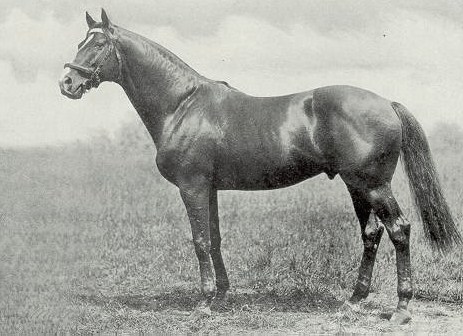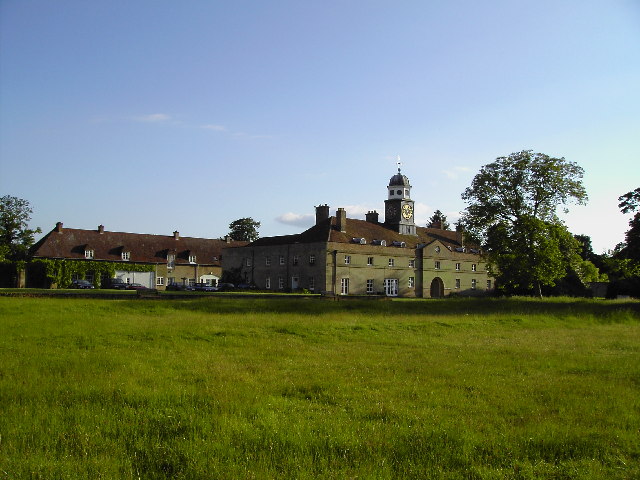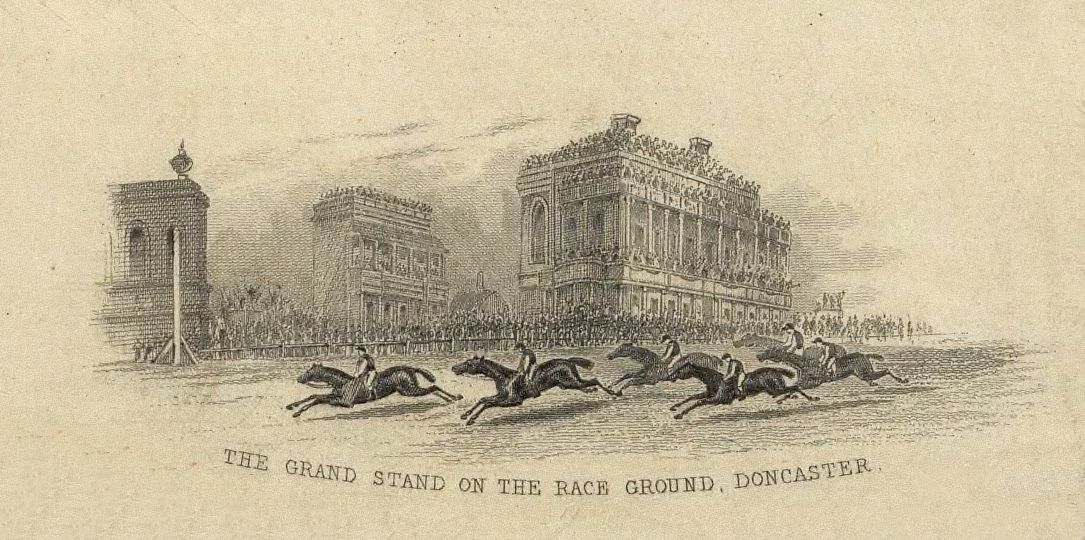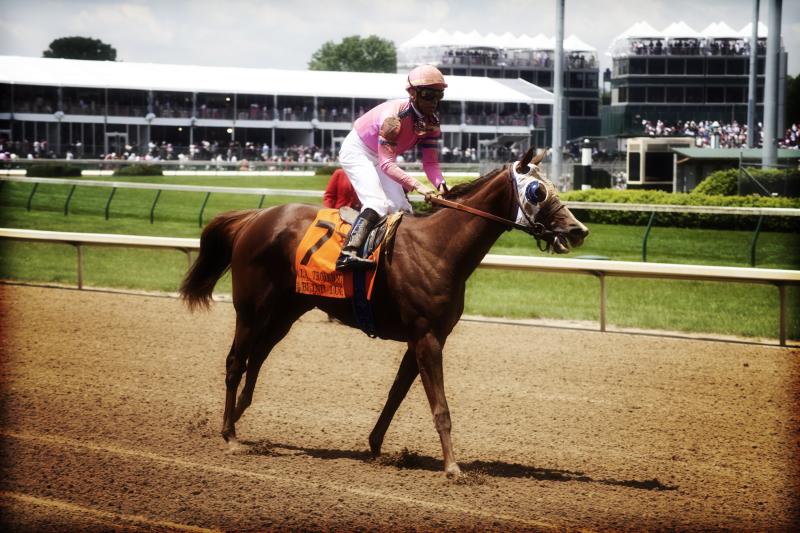|
Plack (horse)
Plack (1921–1940) was a British Thoroughbred racehorse and broodmare. As a juvenile in 1923 when she won three races and finished second to Diophon in the Middle Park Stakes. In the following year she recorded her biggest victory when taking a very strong renewal of the 1000 Guineas and then finished second in the Epsom Oaks. Later that year she added wins in the Newmarket Oaks and the Jockey Club Cup. She failed to win in 1925 but was placed in the Coronation Cup, Hardwicke Stakes, Doncaster Cup and Jockey Club Cup. Despite producing few foals she had some influence as a broodmare. Background Plack was a chestnut mare bred and owned by Archibald Primrose, 5th Earl of Rosebery. During her racing career he was trained by Jack Jarvis at the Park Lodge at Newmarket, Suffolk. Physically, she was described as being built on a "generous scale with a look of speed in the easy play of her limbs". She was from the third crop of foals sired by the unbeaten champion, Hurry On, making h ... [...More Info...] [...Related Items...] OR: [Wikipedia] [Google] [Baidu] |
Hurry On
Hurry On (7 May 1913 – 1936) was an undefeated British Thoroughbred racehorse and sire that revived the Matchem sire line.Leicester, Sir Charles, "Bloodstock Breeding", J.A. Allen & Co, London, 1969 English trainer Fred Darling called Hurry On the best horse he ever trained. Breeding Hurry On was by Marcovil, who won two races and was an ordinary sire. His dam was the unraced Toute Suite by Sainfoin, who sired English Triple Crown winner Rock Sand. Marcovil was inbred to Hermit in the 3rd remove.Pryor, Peter, ''The Classic Connection'', Cortney Publications, Luton, 1979 Hurry On cost his Scotch whisky producer owner James Buchanan, later Baron Woolavington, 500 guineas as a yearling. He was a late colt, having been foaled on 7 May, but he matured into a 17 hands high horse. Racing record As he was a backward late colt, Hurry On was not raced as a two-year-old and was not entered in The Derby. He was undefeated in all of his six three-year-old starts, ranging in distance from ... [...More Info...] [...Related Items...] OR: [Wikipedia] [Google] [Baidu] |
Godolphin Arabian
The Godolphin Arabian (–1753), also known as the Godolphin Barb, was an Arabian horse who was one of three stallions that founded the modern Thoroughbred (the others were the Darley Arabian and the Byerley Turk). He was named after his best-known owner, Francis Godolphin, 2nd Earl of Godolphin. Origins The Godolphin Arabian was foaled about 1724 in Yemen and moved several times before reaching England. At some early age, he was exported, probably via Syria, to the stud of the bey of Tunis. From there he was given to Louis XV of France in 1730. It is believed he was a present from monarch to monarch. Not valued by his new French owner, it is believed he was used as a carthorse. The horse was then imported from France by Edward Coke and sent to his stud at Longford Hall, Derbyshire, where he remained until the death of his owner in 1733. He was bequeathed to Roger Williams, "proprietor of the St. James's Coffee House", who inherited Coke's stallions. He was bought by the 2nd ... [...More Info...] [...Related Items...] OR: [Wikipedia] [Google] [Baidu] |
Doncaster Racecourse
Doncaster Racecourse (also known as the Town Moor course) is a racecourse in Doncaster, South Yorkshire, England. It hosts two of Great Britain's 36 annual Group 1 flat races, the St Leger Stakes and the Racing Post Trophy. History Doncaster is one of the oldest (and the largest in physical capacity) established centres for horse racing in Britain, with records of regular race meetings going back to the 16th century. A map of 1595 already shows a racecourse at Town Moor. In 1600 the corporation tried to put an end to the races because of the number of ruffians they attracted, but by 1614 it acknowledged failure and instead marked out a racecourse. Doncaster is home to two of the World's oldest horse races: The Doncaster Cup The earliest important race in Doncaster's history was the Doncaster Gold Cup, first run over Cantley Common in 1766. The Doncaster Cup is the oldest continuing regulated horse race in the world. Together with the Goodwood Cup and Ascot Gold ... [...More Info...] [...Related Items...] OR: [Wikipedia] [Google] [Baidu] |
Hurst Park
Hurst Park Racecourse was a racecourse at Moulsey Hurst, West Molesey, Surrey, near the River Thames. It was first laid out in 1890 and held its last race in 1962. There was racing at nearby Hampton for many years until 1887. The first meeting at Hurst Park was a jumping fixture on 19 March 1890. The opening race was the Hurst Park Cup, worth £199, over two miles. It was won by Mr. Dougall's Sir Benedict, who also rode it. The first flat meeting was held on 25 March 1891. The Inauguration Plate of £188, over six furlongs, was the first race; it was won by Ready, ridden by W. Wood. The racecourse was the scene of an arson attack by Kitty Marion and Clara Elizabeth Giveen. The two suffragettes were establishing a revenge attack following the death of Emily Davison at the Derby in 1913. Hurst Park's most notable flat race was the Victoria Cup, a handicap over seven furlongs, which transferred to Ascot after the closure of Hurst Park. The Triumph Hurdle, over two miles for four ... [...More Info...] [...Related Items...] OR: [Wikipedia] [Google] [Baidu] |
Blind Luck
Blind Luck (foaled April 20, 2007 in Kentucky) is an American Thoroughbred racehorse. Background Blind Luck is a daughter of Pollard's Vision, winner of the Illinois Derby and the Lone Star Derby, and Lucky One. Blind Luck was purchased for $11,000 as a yearling at the Fasig-Tipton Kentucky Select Sale of 2008 and is now owned by her trainer, Jerry Hollendorfer, as well as Mark Dedomenico, John Carver, and Peter Abruzzo. Racing career 2009: two-year-old season Blind Luck won four of her six career juvenile starts. Two of her wins were in Grade I stakes races: the Oak Leaf Stakes and the Hollywood Starlet Stakes. She also placed third in the Grade I Breeders' Cup Juvenile Fillies behind Shebewild and second in the Grade I Del Mar Debutante Stakes to Mi Sueno. 2010: three-year-old season Blind Luck made her 3-year-old debut a winning one in the Grade I Las Virgenes Stakes where she rallied to win by a nose over Evening Jewel. In the Grade I, $250,000 Santa Anita Oaks, Blind ... [...More Info...] [...Related Items...] OR: [Wikipedia] [Google] [Baidu] |
Ellangowan (horse)
Ellangowan (1920 – 1943) was a British Thoroughbred racehorse and sire. He raced only once as a two-year-old but showed considerable promise when finishing third in a top-class event at Kempton. In the following spring he came in third in the Craven Stakes before recording his biggest win in the 2000 Guineas. Although be made no impact in the Epsom Derby or the St Leger, he had further major victories in the St James's Palace Stakes and the Champion Stakes. He failed to win in 1924 and was retired to stud, but had little success as a breeding stallion. Background Ellangowan was a bay horse bred and owned by Archibald Primrose, 5th Earl of Rosebery. During his racing career he was trained by Jack Jarvis at the Park Lodge at Newmarket, Suffolk. The colt was named after a location in Walter Scott's novel ''Guy Mannering''. He was one of the best horses sired by Lemberg, whose wins included the Epsom Derby, Eclipse Stakes and Champion Stakes. Lemberg also sired the Epso ... [...More Info...] [...Related Items...] OR: [Wikipedia] [Google] [Baidu] |
Colombo (horse)
Colombo (1931–1954) was a British Thoroughbred racehorse and sire. In a career that lasted from April 1933 to June 1934 he ran eleven times and won nine races. Colombo was an outstanding two-year-old, unbeaten in seven races in 1933 and drawing comparisons with champions such as Isinglass, Persimmon and Bayardo. In 1934 he maintained his unbeaten record by winning the Craven Stakes and the 2000 Guineas at Newmarket and then finished third as the favourite in The Derby. After one more unsuccessful race he was retired to stud, where he had some success as a sire of winners until his death in 1954. Background Colombo, a large, powerful, lop-eared horse with a "raking, effortless stride" was bred by the shipping magnate Sir Alec Black. He was bay with a white star, a white sock on his left foreleg and a white coronet on his right hind leg. Shortly after Colombo was foaled, Black decided to sell off his bloodstock and the colt was bought relatively cheaply for 510 guineas by Lor ... [...More Info...] [...Related Items...] OR: [Wikipedia] [Google] [Baidu] |
Aunt Edith
Aunt Edith (1962–1986) was a British Thoroughbred race horse and broodmare. In a career which lasted from 1964 until October 1966 she ran nine times and won four races. As a three-year-old in 1965 she won the Nassau Stakes and the Prix Vermeille. In 1966 she won the Yorkshire Cup before becoming the first filly to win the King George VI and Queen Elizabeth Stakes. After being retired from racing she became a successful broodmare. Background Aunt Edith was a chestnut mare bred by Colonel C. B. Hornung. She raced in the colours of her breeder's son John Hornung. She was sired by Primera, a stayer from the Byerley Turk sire line, who won two runnings of the Princess of Wales's Stakes and the Ebor Handicap. Her dam, Fair Edith, was of no account as a racehorse, but was a daughter of Afterthought, who finished second to Sun Chariot in the 1942 New Oaks. The filly was sent into training with Noel Murless at his Warren Place stable in Newmarket, Suffolk. As a descendant of the br ... [...More Info...] [...Related Items...] OR: [Wikipedia] [Google] [Baidu] |
Sweet Solera
Sweet Solera (1958–1978) was an Irish-bred, British-trained Thoroughbred racehorse. In a racing career lasting from June 1960 until June 1961, the unfashionably-bred filly ran eight times and won six races. As a two-year-old she was beaten in her first two races, but her five-lengths win in the Cherry Hinton Stakes at Newmarket Racecourse was enough to see her rated among the best juveniles of the year. Sweet Solera was unbeaten in four races including the 1000 Guineas at Newmarket and Oaks at Epsom. She was then retired to stud, and had some success as a broodmare. Background Sweet Solera was a "big, handsome" chestnut filly with a broad white blaze and a long white sock on her left hind leg, bred in Ireland by Mrs D. M Walker. Her sire, Solonaway won the Irish 2,000 Guineas over a mile, but was better known as a sprinter. In the year of Sweet Solera's birth he was exported to Japan, where he became Champion sire in 1966. Her dam, Miss Gammon, won three minor races and ... [...More Info...] [...Related Items...] OR: [Wikipedia] [Google] [Baidu] |
Precipitation (horse)
Precipitation was an influential British bred Thoroughbred stallion who is found in the pedigrees of many racehorses and sport horses today. He is responsible for helping maintain the Matchem sireline, through his son Sheshoon. Pedigree He was by Hurry On and out of Double Life, a foundation mare of the famous British stud, Someries Stud. Hurry On, the sire of Precipitation, was unbeaten in his six starts and sired three winners of The Derby during the 1920s. Double Life was a good racemare that won six races worth £5,647 and then proved to be an exceptional broodmare. Her foals included Casanova (a winner and a good sire), Persian Gulf (Coronation Cup and outstanding sire) and Doubleton who was the grandam of Meld.Leicester, Sir Charles, ''Bloodstock Breeding'', J.A. Allen & Co, London, 1969 Racing record Precipitation did not race until he was three owing to a heel problem.Hislop, John, ''Breeding for Racing'', Martin Secker & Warburg, London, 1976, He did well on the track ... [...More Info...] [...Related Items...] OR: [Wikipedia] [Google] [Baidu] |
Cresta Run (horse)
Cresta Run (1924 – 1939) was a British Thoroughbred racehorse and broodmare. As a two-year-old in 1926 she showed steady improvement, winning two of her i races including the valuable Imperial Produce Stakes. On her three-year-old debut she recorded a very impressive win in the 1000 Guineas but failed to reproduce her form in two subsequent races over longer distances. She had little immediate success as a broodmare but had a long-term influence on the breed though her daughter Gold Race. Background Cresta Run was a bay mare bred and owned by Giles Loder who owned the Eyresfield Stud in County Kildare. Throughout her racing career she was trained by Peter Gilpin at his Clarehaven Stable in Newmarket, Suffolk. She was described as a "charming filly" with "well-developed quarters" and an "intelligent head". She was from the sixth crop of foals sired by the unbeaten champion, Hurry On, making her a representative of the Godolphin Arabian sire line. Hurry On sired numerous oth ... [...More Info...] [...Related Items...] OR: [Wikipedia] [Google] [Baidu] |
Pennycomequick (horse)
Pennycomequick (1926 – October 1945) was a British Thoroughbred racehorse and broodmare. She showed promise as a two-year-old in 1928 when she won her only race by a wide margin. In the following year she won two races including a very impressive victory in the Epsom Oaks. She failed when made favourite for the St Leger and was retired from racing after sustaining a serious leg injury in autumn. She became a very successful broodmare, producing several major winners. Background Pennycomequick was a brown mare "of great power and quality" bred in the United Kingdom by her owner Waldorf Astor, 2nd Viscount Astor. She was sent into training at Manton, Wiltshire with Joseph Lawson who had inherited the stable from Alec Taylor, Jr. in 1927. She was from the eighth crop of foals sired by the unbeaten champion, Hurry On, making her a representative of the Godolphin Arabian sire line. Apart from Pennycomequick, Hurry On sired numerous major winners including Captain Cuttle, Cor ... [...More Info...] [...Related Items...] OR: [Wikipedia] [Google] [Baidu] |





